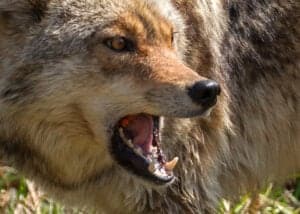Coyotes Canis latrans are a familiar North American native dog species with wide-ranging territory. This fascinating mammal is hardy, adaptable, and clever, and with the increasing demise of its natural enemy, the gray wolf, their range has increased to an epic extent. Let’s discover coyotes in North Carolina, including the estimated population number, hunting rules, and which counties have the most sightings.

Coyotes have moved into gray wolf territory over the past few hundred years.
©Steve Byland/Shutterstock.com
Coyote Population in North Carolina
Until 1988, coyotes didn’t exist in the state, other than a few illegally imported individuals for sport hunting, but a little more than 20 years later, coyotes appeared in every North Carolina county.
No exact figures indicate the coyote population in North Carolina, but it’s assumed there is a healthy population in both rural and urban areas because they wander into the towns and cities of every county.
N.C. Wildlife Resources Commission says coyotes are impossible to count because their home range varies from two to 25 miles depending on the season. When coyote groups lose members, females respond with larger litters. This means the number fluctuates and replenishes so frequently that wildlife officers can’t pin it down.
The only real data we have on North Carolina’s coyotes are the hunting stats:
- 2007-2008 4,000 reports
- 2010 – 10,000 reports
- 2017 – 55,000 reports
Of course, these increased numbers may be due to increased reporting, but even so, the increased kill total is staggering, and it indicates a large number of coyotes in North Carolina, especially when we consider neighboring Georgia has an estimated population of 250,000 coyotes.
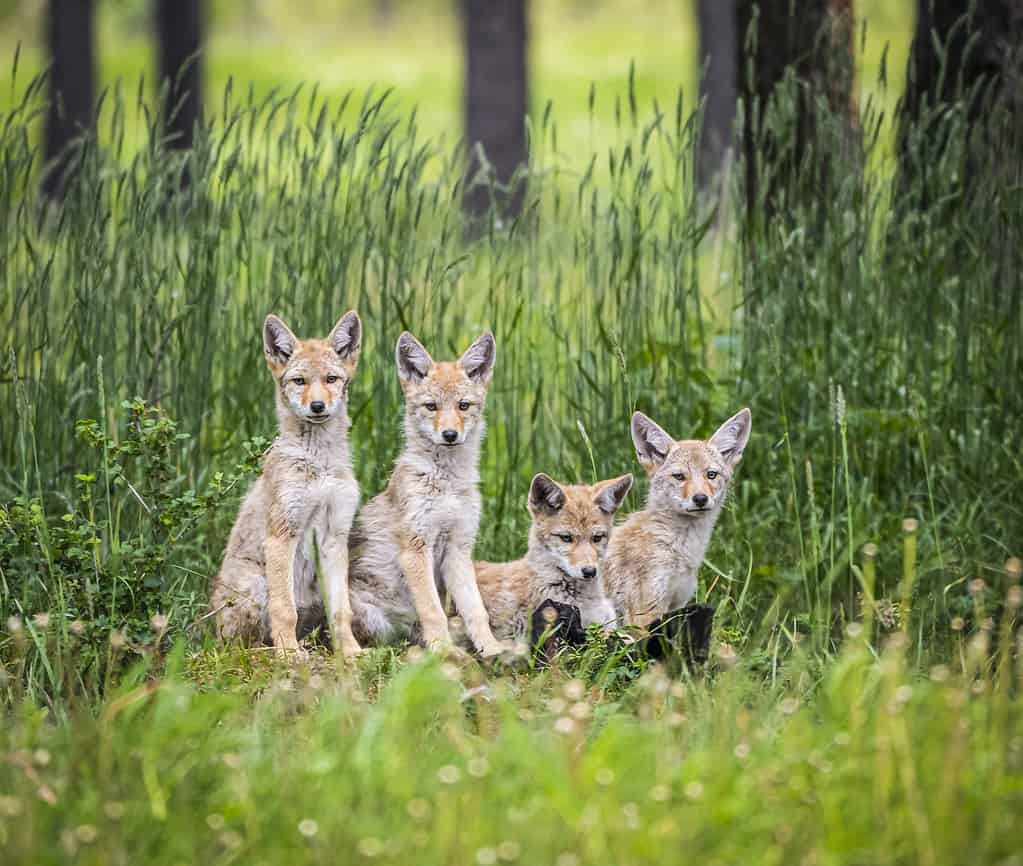
Hunters killed over 50,000 coyotes in North Carolina during 2016-2017.
©Annie Hewitt/iStock via Getty Images
Coyote: Species Overview
Coyotes are wild North American canines that live in small family groups. They reach slightly smaller sizes than their gray wolf competitors with light gray, red, black, and white merged coats. Desert coyotes have lighter, thinner coats than their darker, thicker-coated northern cousins.
19 subspecies exist across the Americas, primarily feeding on small mammals like rabbits, but also reptiles, fish, and invertebrates. Omnivorous by nature, coyotes also enjoy fruit, vegetables, grain, and carrion.
Males weigh up to 44 pounds, with females just a little lighter. The largest coyote ever caught weighed a whopping 75 lbs and measured 4 feet 11 inches long. Coyotes build dens beneath fallen logs, under ledges, and in caves where the female gives birth to a litter of pups.
Biologists consider coyotes the most vocal of all North American mammals, and their scientific name, Canis latrans, even means ”barking dog.” The term coyote comes from Spanish cóyotl, which means ‘trickster.’ Other names for this hardy and resilient canine include prairie wolf and brush wolf.
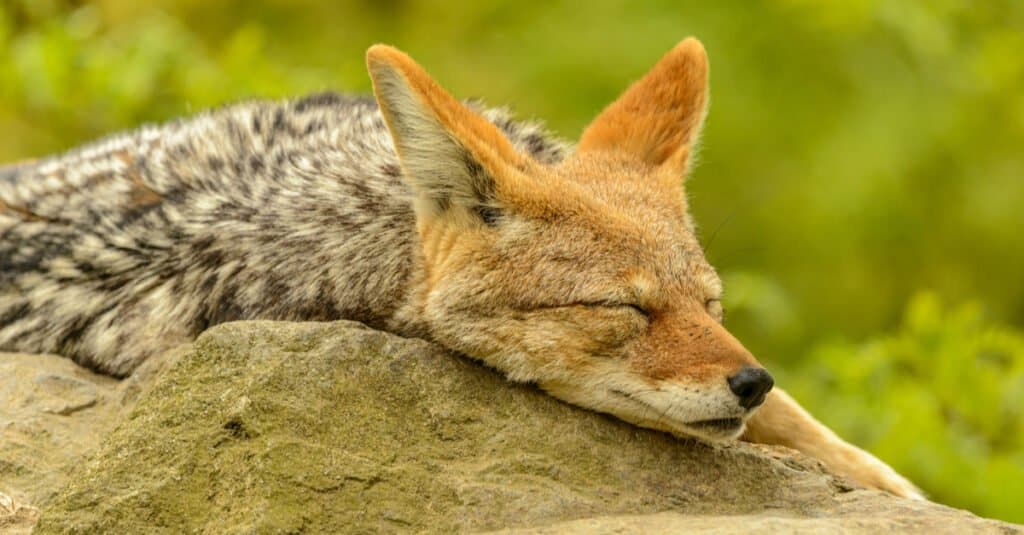
Coyotes eat small mammals, birds, and reptiles, plus fruit, veg, and carrion.
©Petr Ganaj/Shutterstock.com
Are They NC Natives?
Coyotes live in all 100 of North Carolina’s counties, but they’re not native to the state.
When Europeans colonized North America, coyotes lived in the central Great Plains. It wasn’t until 1988 that a coyote was first spotted in western North Carolina. Their arrival was due to natural expansion from South Carolina, Georgia, and Tennessee. Any coyotes spotted before the mid-to-late 1980s were illegally imported for hunters and hound runners.
Wolves hemmed in the coyote population hundreds of years ago. The two species didn’t coexist well because they preyed on the same animals and needed the same types of habitat. At this point, coyotes ranged from the Sonoran Desert to Alberta. However, overhunting led to a shrinking wolf population. Coyotes were quick to take advantage of the gap, expanding their range to fill the void.
Because coyotes are so adaptable, they’re capable of living in a wide variety of places. North Carolina’s forests, slopes, grasslands, and towns suit them well.
Of all the native North American species, the government has used more resources to control the coyote population. Extensive population control measures are carried out in neighboring states, too, but coyotes have survived and expanded their range. Wildlife researchers suggest it’s due to their ability to use human habitats and produce larger litters when the population shrinks.

Coyotes live in a wide range of habitats, including deserts, forests, farmland, and agricultural fields.
©fusaromike/iStock via Getty Images
Common Locations in North Carolina
Coyotes inhabit every county in North Carolina State, but hunting stats suggest more are killed in the Piedmont counties. Fewer coyotes are trapped or shot in the mountains or near the coast. According to the North Carolina Wildlife Resources Commission (NCWRC), Wake County has the highest number of recorded coyote sightings, with 76 identifications in 2018, followed by:
- Mecklenburg – 71
- Forsyth – 47
- Gaston – 39
- New Hanover – 34
Townsfolk are more likely to spot coyotes in November and December when youngsters begin to leave the family group to find new territory. The NCWRC says young coyotes don’t know where they are going, so they turn up in odd places, including yards, schools, and playing fields.
A coyote’s natural habitat includes forests, deserts, grasslands, and swamps, but they’ve adapted to human landscape changes and now inhabit North Carolina’s agricultural fields and suburban neighborhoods, too. They’re secretive about it, though; you may never know about your coyote neighbors.
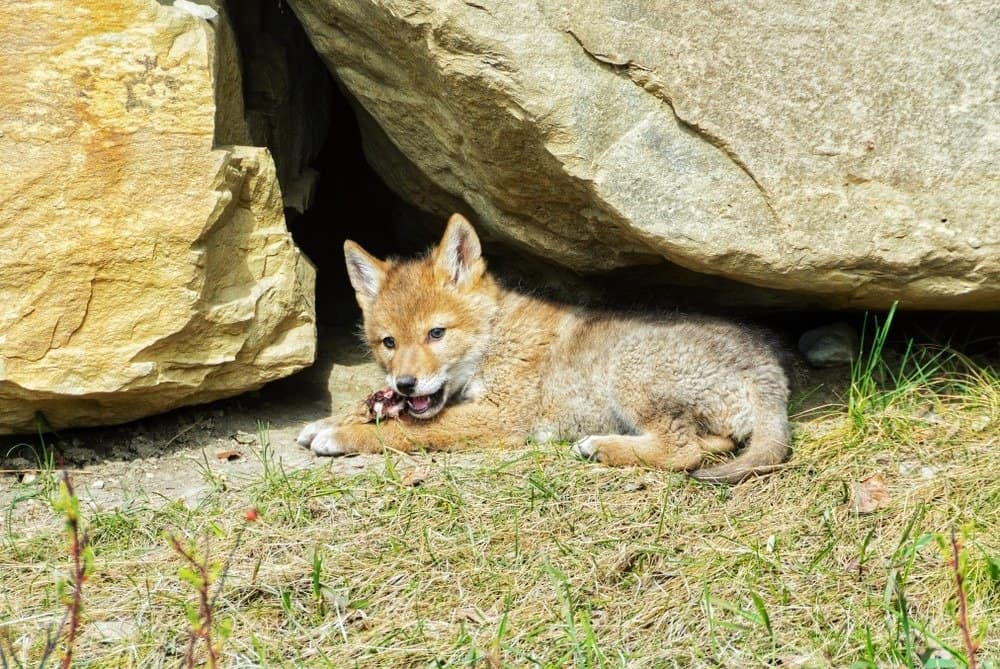
Young coyotes leave the family group in November to December, so sightings rise.
©Muriel Lasure/Shutterstock.com
What Are the Hunting Rules for Coyotes in North Carolina?
Across most of North Carolina, it’s legal to hunt, shoot, and trap coyotes. There’s no closed coyote hunting season, and all that’s required is a hunting license, a big game license, and:
- Hunting on private land: written permission from the landowner.
- Hunting on public land: permit from the state.
Bear in mind it’s illegal to hunt coyotes in national parks and national forests unless it’s on game land. It’s also worth checking county rules too. North Carolina’s coyote hunting rules are divided into eight zones. Each zone has its own regulations.
In North Carolina, the coyote is designated as an invasive species, and it’s the only animal, alongside feral pigs, hunted at night with lights and electronic call signals. There isn’t a bag limit.
However, in Beaufort, Dare, Hyde, Tyrrell, and Washington counties, hunters need a Coyote Hunting or Coyote Depredation Permit due to ongoing studies and the red wolf reintroduction project.
After the hunt, killed coyotes must be tagged and reported to the NCWRC within 24 hours. It’s mandatory, and hunters are landed with a large fine for ignoring the rules. Reporting coyote harvest helps the Wildlife Commission estimate the state’s coyote numbers and aids effective management plans if required.
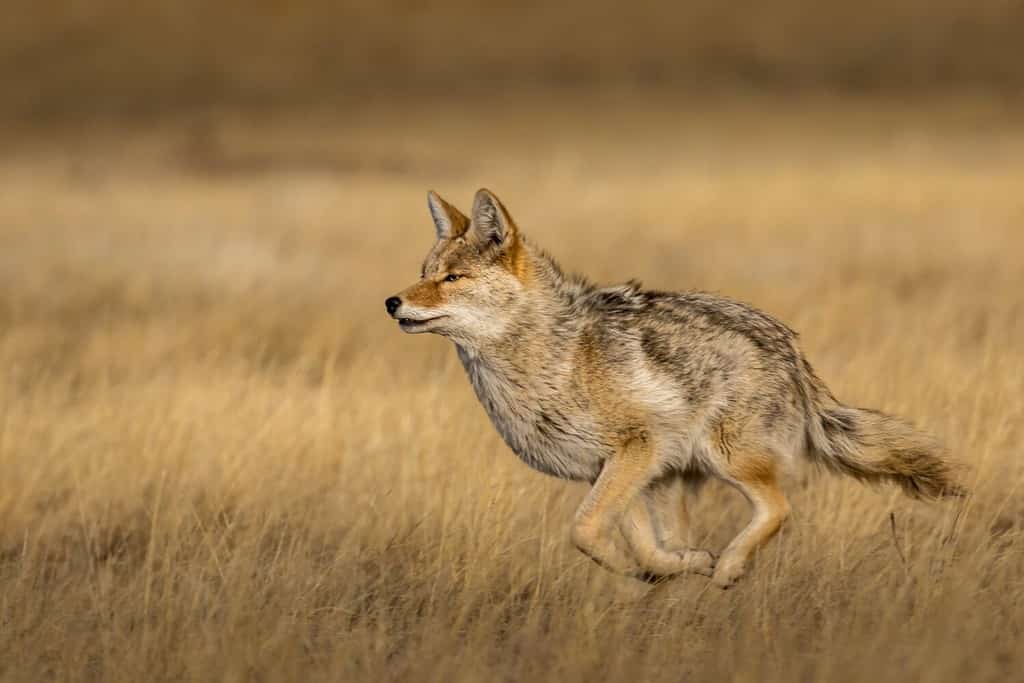
Hunters must tag, and report coyote kills to the NCWRC within 24 hours.
©Dennis Laughlin/Shutterstock.com
Does Hunting Control Coyote Numbers?
Experts cast doubt on hunting as an effective coyote control method due to litter numbers that drop when the population is high and double when the population thins out. Hunting coyotes may only encourage breeding.
Biologists suggest coyotes are taking over the ecosystem hole left by humans overhunting wolves. It’s an important role that keeps the wild animal population in check. Coyotes also prey on rodents, raccoons, and other animals some households consider pests in suburban areas.
Are Coyotes a Problem in North Carolina?
Coyotes are skittish, shy canines that avoid humans, so they’re not generally a danger. They may become bolder when cubs are born, and they’re naturally attracted to bird feeders, veggie patches, and compost heaps. Only 142 reports of coyote attacks in the USA and Canada exist. When we compare it to the 7,000–8,000 people per year that receive venomous snake bites in the United States alone, the number is tiny.
Small dogs, cats, or other pets like rabbits or lizards are natural prey animals for coyotes, and they may take them if the opportunity presents itself. This fear creates natural worry about wild coyotes in the neighborhood, so Wildlife Control has produced information on living with coyotes.
Highlights include accepting that coyotes have colonized North Carolina and how to live with them safely because they aren’t going anywhere.

Coyotes pose very little threat to humans.
©iStock.com/dmodlin01
How Many Coyotes Are There in North Carolina?
Experts don’t know how many coyotes live in North Carolina because the population varies so quickly, and coyotes travel many miles to hunt and mate. It’s difficult to put a number on the amount, but the most recent hunting figures estimate over 50,000 coyotes were killed between 2016 and 2017.
With neighboring Georgia estimating their coyote population at around 250,000, it seems realistic to estimate North Carolina has a similar population, especially with its high kill total.
The photo featured at the top of this post is © KenRinger/iStock via Getty Images
Thank you for reading! Have some feedback for us? Contact the AZ Animals editorial team.



